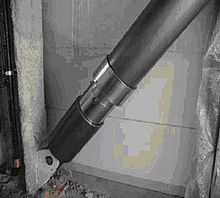Hysteretic damper
| |
Educational level: this is a research resource. |
Hysteretic damper is intended to provide better and more reliable seismic performance than that of a conventional structure at the expense of the seismic load energy dissipation.[1] There are four major groups of hysteretic dampers used for the purpose, namely:

Fluid viscous damper installed in a building structure
- Fluid viscous dampers (FVDs)
- Metallic yielding dampers (MYDs)
- Viscoelastic dampers (VEDs)
- Friction dampers (FDs)
Each group of dampers has specific characteristics, advantages and disadvantages for structural applications.
See also
References
| |||||||
This article is issued from Wikiversity - version of the Friday, November 21, 2014. The text is available under the Creative Commons Attribution/Share Alike but additional terms may apply for the media files.
